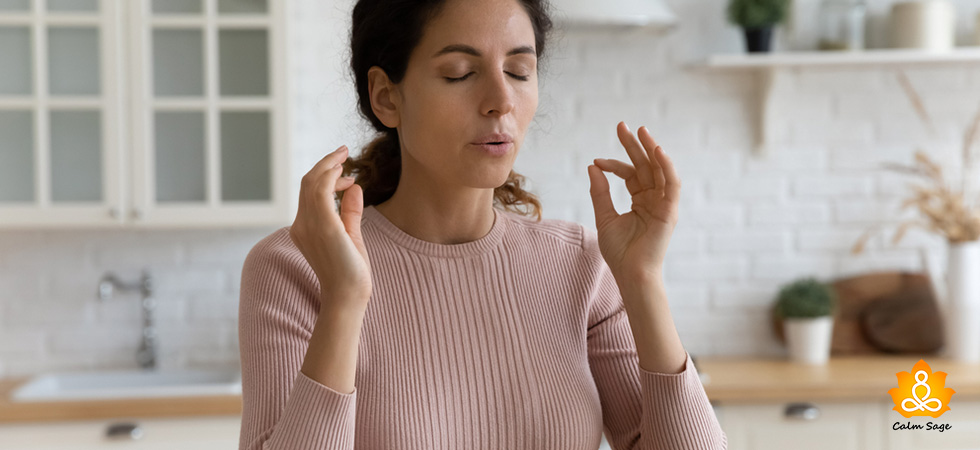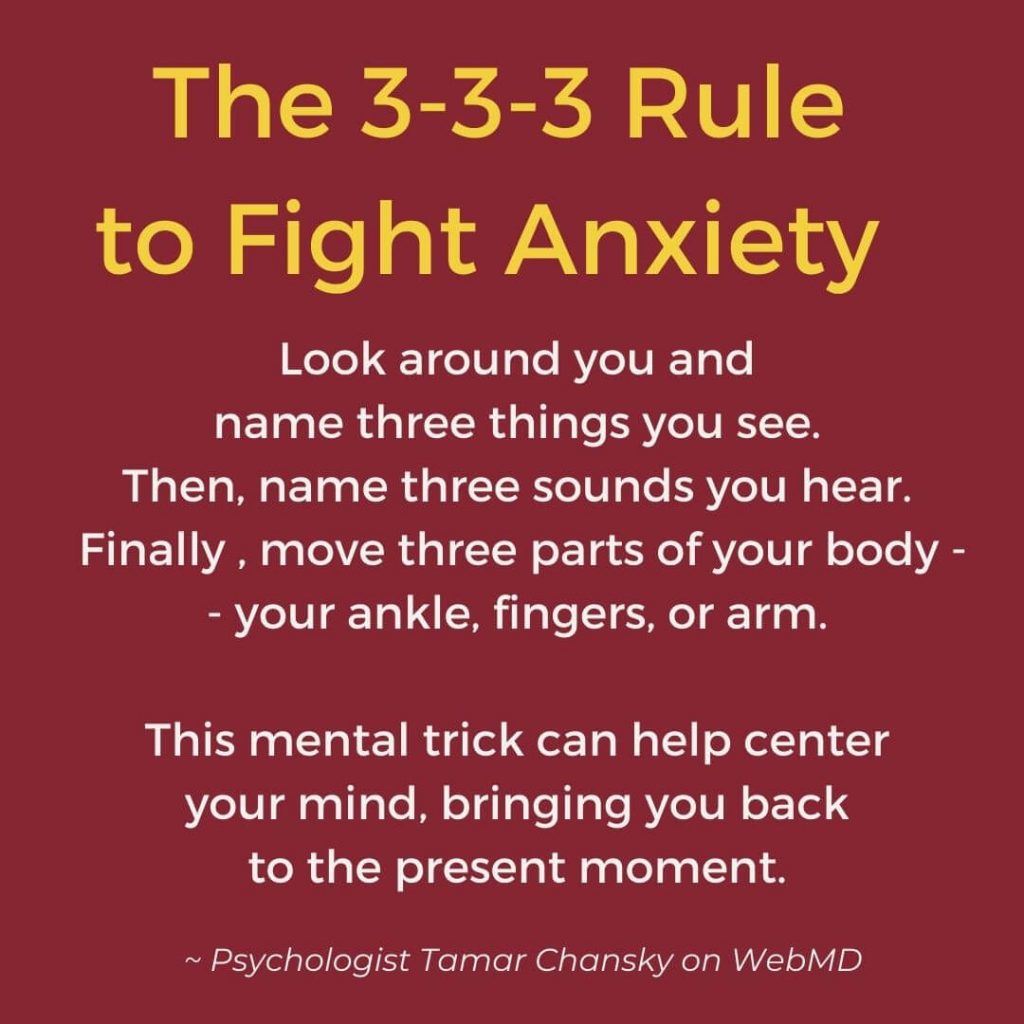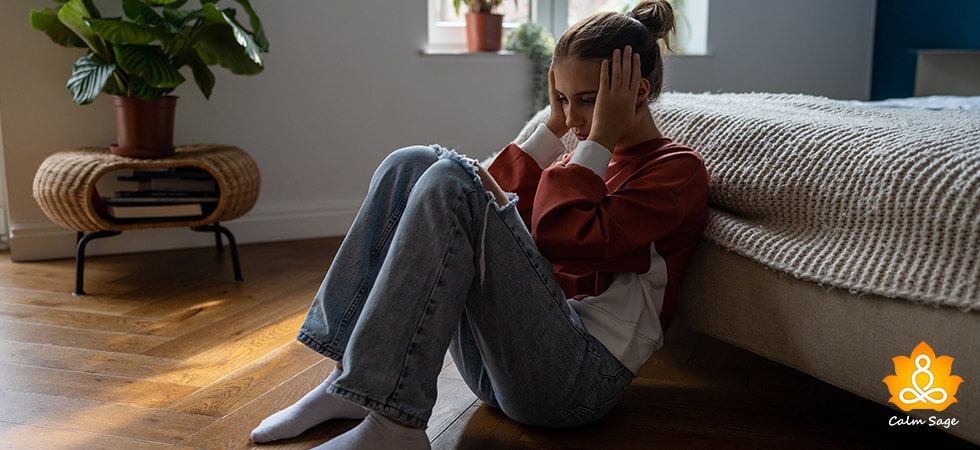The 333 Rule For Anxiety: What Is It And How It Helps

Imagine you’re sitting in your room, relaxing, then out of nowhere your palms begin to sweat, your heart rate increases, and you feel out of control – this is what having anxiety feels like. One moment you’ll be relaxing and the next, you’ll be feeling all out of sorts…
For many people, anxiety is triggered by an event such as an argument, moving to a new city, or going through a tough time. Other times, anxiety can be triggered by your bottled-up emotions, feelings, or thoughts.
It is completely normal to get overwhelmed or nervous but when these feelings are persistent and begin to interfere with your daily functioning, then it can be diagnosed as an anxiety disorder. One of the most common anxiety disorders (worldwide) is Generalized Anxiety Disorder or GAD, which can cause panic, overwhelming fear, heart palpitations, trembling, shaking, or even experience panic.
Of course, to help with anxiety, there are some long-term and short-term therapy treatments or
medications. But everyone struggling with any anxiety disorder can’t benefit from making
lifestyle changes or alternative ways to reduce stress and anxiety.
Then, what can help with anxiety?
In this article, I’ll be helping you understand one particular self-help strategy to manage anxiety. The 3-3-3 Rule For Anxiety. Practicing this 333 rule will help you relax your body, find your center, and regain your control.
The 333 Rule For Anxiety

When it comes to anxiety, stress, or even panic attacks there are some things you can try to ease your mind.
This 333 rule might not seem as extensive as other techniques but it is a very simple yet effective technique to reduce stress and find your calm, even if you’re overwhelmed at work.
Whether you sense your anxiety at work or home, the 333 rule for anxiety asks you to focus on:
1. Sight
Take a pause and look around you. Bring your attention to 3 physical objects around you. Look at them and name them. Pay close attention to the details. For example; You see a flower vase, a bottle of water, and a book. Pay close attention to each object. What color is the vase, what about the design? Is the water bottle full? Is it cold, hot? What kind of book is it? Paperback, hardcover?
2. Sound
Next, you need to look around for 3 things that are within your sight and hearing range. Listen to three sounds you can hear and name them. Again, pay close attention to the details, for example; the pitch, the cadence of each sound.
3. Touch
The last thing you need to do is engage your sense of touch. Choose 3 body parts you can move. You can use your arm, legs, and ankles for this part. For example; wiggle your toes, rotate your ankles, tap your fingers, move your arms, etc.
With the three senses engaged – sight, sound, and touch – you can create a soothing symphony in your mind to pull you out of your panic.

Combined with deep breathing, the 333 rule can have a calming effect on your mind and body. Practicing this technique will help with anxiety, center your mind, and bring you to the present
moment.
The Benefits Of The 3-3-3 Rule

Living with anxiety or an anxiety disorder is not easy but when you employ the right techniques, managing anxiety and panic can be easy. If you’re constantly struggling with managing your anxiety or being overwhelmed at work, you can practice the 333 rule.
By practicing this technique, you can learn to:
- Helps you pull away from negative emotions and feelings
- Keep your mind away from unwanted thoughts
- Helps distract your mind from the panic
- Helps you stay in the present moment
Grounding techniques such as the 333 rule may not be easy to practice when you’re in the middle of a panic attack, and especially difficult when dealing with anxiety at work. It might take time to build the technique but keep practicing.
Top Tips for When Using the 333 Rule for Anxiety
- Even if you don’t feel distressed, keep practicing the technique. It might come in handy when you do experience distress.
- Don’t wait. If you just feel a little stressed, practice the grounding exercise. It’s better to not wait for when the stress or anxiety becomes too much.
- When you’re practicing the 333 rule, make sure you keep your focus on your environment only. Don’t focus on your feelings but the things around you.
- Check in with yourself 10 minutes before and after. Rating your distress before and after can help you understand how well your grounding technique worked.
- Keep your eyes open. Many people find closing their eyes helpful but when you’re practicing the 333 rule, make sure you keep your eyes open.
Grounding techniques, whichever you prefer, can help you regain control, find your calm, and help relax. If these techniques are not helping, it is suggested you reach out to a professional for help. Remember, this technique can also help if you’re struggling with generalized anxiety, health anxiety, or just overwhelmed at work.
Common Types of Anxiety To Know
Many of us feel anxious from time to time. Some of us feel temporarily anxious about our careers, health, family, or relationships, but anxiety can become overwhelming soon too. When anxiety becomes your constant companion, it can interfere with your daily routine and can impact your quality of life as well.
When anxiety turns chronic, it can cause more than just jitteriness; it can make you want to isolate yourself to avoid people, avoid your responsibilities, and even prompt negative thoughts. If this is a familiar feeling for you, then you might have an anxiety disorder.
Here are some common types of anxiety disorders you need to know about. If you relate to any of the following disorders, then it is strongly recommended you speak to a professional for an appropriate diagnosis and treatment plan;
1. Generalized Anxiety Disorder (GAD):
When anxiety symptoms become your constant companion, that’s when it can become a generalized anxiety disorder. GAD causes persistent feelings of anxiety and worry.
2. Panic Disorder:
Panic disorder is another type of anxiety wherein you experience frequent and often recurring panic attacks. Panic attacks in panic disorders can be sudden and intense.
3. Social Anxiety Disorder (SAD):
Many of us experience social anxiety when it comes to presenting in front of a huge crowd. It’s OK, though. But, when your anxiety turns into a persistent fear of being rejected or being judged by others, then it can become a social anxiety disorder (SAD).
4. Phobia-Related Disorders:
When irrational fears take center stage in your life and cause you to feel extremely anxious and fearful, then it can also be considered an anxiety disorder. Phobia-related anxiety can be related to open spaces (Agoraphobia), heights (Acrophobia), or confined spaces (Claustrophobia).
Professional Treatment For Anxiety
I have mentioned healthy coping strategies in this article to help you calm your anxiety more naturally. However, these coping strategies might not always help you address the root causes of your anxiety.
Here are some professional treatment options you can consider to fully address and treat anxiety;
1. Therapy:
In many ways, therapy is considered an effective treatment for treating anxiety. Some common therapy techniques that can help treat anxiety include;
2. Cognitive-Behavioral Therapy (CBT):
CBT is an evidence-based approach that can help you identify and understand negative thought and behavior patterns and change them into positive ones.
3. Exposure Therapy:
This is another practical therapy approach wherein you’re exposed gradually to a fearful or anxiety-inducing situation (under a therapist’s guidance) to help you reduce your anxiety or fear response to a trigger.
4. Acceptance and Commitment Therapy (ACT):
ACT is a therapy approach that uses techniques such as mindfulness and changing behaviors, without engaging in judgment, to cope with anxiety and its symptoms.
5. Eye Movement Desensitization and Reprocessing (EMDR):
EMDR uses a unique approach wherein eye movements and tapping are utilized to heal from anxious feelings and past negative experiences.
4. Dialectical-Behavioral Therapy (DBT):
This is another evidence-based and comprehensive treatment approach that uses CBT techniques and meditation to help you cope with anxiety.
5. Medications:
More specifically, prescribed medications can be used along with therapy to treat anxiety and its symptoms. A professional healthcare provider can prescribe you antidepressants, antianxiety medications, or beta blockers to help with anxiety.
It is strongly recommended that you take only prescribed medications as many of them can have adverse side effects that can worsen your anxiety. Talk to your physician about the side effects before taking any medication.
What to Take Away?
Anxiety can affect different aspects of your life. The 333 rule of anxiety is a simple technique that can help you calm your nerves when your anxiety is triggered.
This exercise simply needs you to look around, notice three physical objects, and three sounds you can hear, and engage three of your body parts to create awareness of the present moment.
If your anxiety persists, then you might need to speak with a professional and seek an assessment and treatment plan to treat your chronic anxiety. Therapy, medications, or a mix of both can help you address and treat your anxiety symptoms.
Coping Strategies For Anxiety
If you’re still struggling with anxiety despite practicing the 333 rule for anxiety, here are some coping strategies that might help you;
- When you feel anxious, take some time and remove yourself from the situation. Take a walk or listen to some calming music. Just stop and distract yourself from the situation.
- Drink plenty of water. Avoid alcohol or caffeine in this case because these beverages can make your anxiety worse.
- Get some naps and eat a healthy meal. Your body can give signals to your brain too so make sure your body is taken care of.
- Take deep and mindful breaths. Try to focus on the present moment and sensations going through your body in the present moment.
- Try gentle movement exercises like yoga for anxiety or tai chi. These exercises can be great ways to reduce excessive adrenaline and calm down the stress response.
To connect with a licensed and trained professional you can click here. You can also write to us at info@calmsage.com or DM us on social media.
I hope this article helped you understand the 3 3 3 rule for anxiety. If you found this article helpful, let us know in the comments below!
Be kind to yourself.
Take Care!
Frequently Asked Questions
Q1: Does the 333 rule work for anxiety?
The 333 rule of anxiety is very simple and works wonders! All you need to do is look around you and name three things you see, three things around you hear, and three things you can touch or move around your body.
This mental trick to calm anxiety is very helpful as it takes your attention from what’s causing you to feel anxious to focus on something you can control.
Q2: How can I reduce anxiety immediately?
When you’re feeling anxious, all you need to do is bring yourself to the present moment and pay notice of attention to the little things around you. For example, pay attention to the book in front of you and take in the details of the book; the color of the book, the texture of the cover, etc.
Now you need to look for sounds that you can hear, for example, the tweets of the birds. Pay attention to it. Next, you need to move three body parts, for example, wiggle your toes, tap your fingers, or move your arms around.
This 333 anxiety rule is a way to reduce anxiety immediately.
Q3: What are 3 strategies for managing anxiety?
To manage anxiety, you need to
- Regulate your breathing: Anxiety makes your breathing shallow and fast. To calm down from your anxious high, you need to slow down your breathing.
- Progressive muscle relaxation: Anxiety can also make you tense your muscles and make you feel stiff. To relax your muscles, the best way is to deliberately tense them and then release them while paying attention to the sensations created.
- Be in the present moment: When you’re anxious, your mind ruminates on negative thinking of the past or worries about the future. To avoid this thinking, you need to be present in the moment. That can be done by practicing the 3-3-3 anxiety rule.
Q4: How do you get rid of anxiety in 5 minutes?
To get rid of anxiety in 5 minutes, you can:
- Practice the 3-3-3 anxiety rule
- Sniff some lavender essential oil
- Watch a calming video on YouTube
- Go for a quick walk in nature
- Listen to your favorite songs
- Identify your anxious feelings and their causes
- Identify the triggers and eliminate them
- Walk away from the stressful situation





















Golden! I appreciate this article so much. Thank you for putting it out into the world. Sending big smiles and warmth your way!!
Ready to practice this strategy